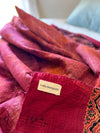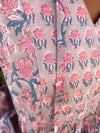
The Double Ikat of Patan, also known as Patola, is one of the most precious treasures of India's textile heritage, renowned worldwide for its complexity, unparalleled beauty, and profound symbolism. This artisanal masterpiece, crafted by the expert hands of weavers in the city of Patan, in the state of Gujarat, represents the pinnacle of refinement and mastery in weaving, the quintessence of ancestral know-how, and the legacy of a tradition that stretches back centuries.
The Perfection of Double Ikat: An Extraordinary Technical Challenge
Unlike traditional Ikat, where only the warp or weft threads are dyed before weaving, double Ikat is a technique that defies comparison. In Patola de Patan, the warp and weft threads are knotted and dyed even before weaving, demanding absolute precision. Each motif is meticulously planned so that the colors and patterns come together perfectly during the final weaving, creating incredibly crisp and intricate designs.
This process is infinitely laborious: each thread must be knotted by hand, dyed repeatedly, and then readjusted to achieve perfect synchronization. It can take months of painstaking work to produce a single piece of Patola. The degree of precision is such that a deviation of just a few millimeters can ruin the entire design. Each piece of double Ikat is therefore a work of patience, rigor, and dedication, where each thread tells a story of meticulous effort and passion.
Patan Patola is distinguished not only by its technique but also by its iconic motifs, rich in symbolism. The geometric, floral, and animal patterns found on these fabrics originate from an ancient language, passed down through generations. These motifs, often sacred, reflect the cultural and spiritual richness of India. Designs such as elephants, peacocks, lotus flowers, and complex geometric shapes are not only aesthetically pleasing but also carry profound meaning.
These motifs have long been associated with royalty and the elite. In the past, only kings and nobles could afford Patola sari pieces, due to their lengthy and expensive production. Even today, Patola remains a symbol of prestige, often worn on important occasions such as weddings and religious ceremonies. To don a Patola sari is to wear a piece of history spanning millennia, a sacred work of art that connects the past and the present.
Patola from Patan is renowned for its exceptional durability. Thanks to the quality of the natural fibers used, such as silk, and the natural dyes that permeate each thread, Patola resists the test of time. This fabric has a reputation for retaining its vibrant and brilliant colors even after generations. The colors, derived from natural dyes like indigo, madder root, or saffron, maintain unparalleled depth and luminosity. This makes Patola a timeless fabric that never loses its beauty and prestige.
Despite its grandeur and renown, Patan double Ikat is now an endangered craft, practiced by only a small number of artisan families, heirs to this centuries-old tradition. The production of a Patola sari, which can require six months to a year of intensive work, makes this fabric rare and precious.




0 comments